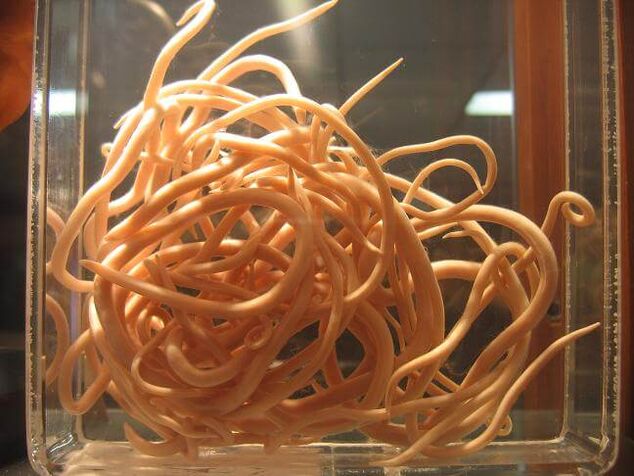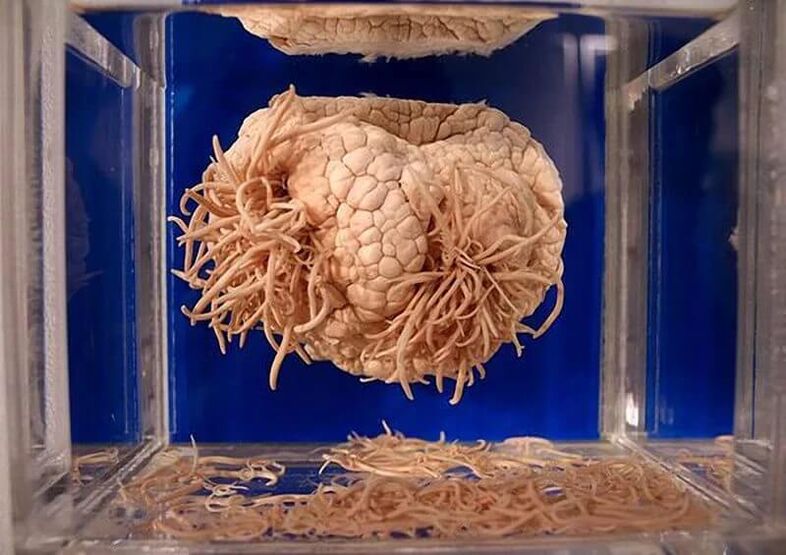Worms or helminths are parasites that live, feed, grow and reproduce in the human body, or in other words, use it to carry out their life cycle. According to various statistics, there are from 300 to 500 species of worms in the world that are dangerous to humans. Their prevalence varies by country and depends on the level of hygienic culture of the population and the socio-economic development of the region. But even in enlightened European countries, symptoms of helminthiasis are found in a third of the population. Worm larvae can enter the human body in many different ways, depending on their development cycle. The names of human worms, their varieties, as well as methods of infection, symptoms and treatments of helminths are information relevant to the majority of the world's population.

What types of worms are there?
Over many years of evolution, parasites have ideally adapted to live at the expense of other organisms without causing suspicion in the immune system for a long time, as a result of which symptoms of infectionWorms in humans do not appear immediately and may be completely absent or mild. expressed.
Worms have the ability to enter the body unnoticed, disguise themselves, destroy tissues and organs, poison the human body with toxins, and live for a long time.
Some types of heartworms are dangerous to humans, while others are parasitic in animals. Their size varies from microscopic to giant (15 meters long or more). About three dozen types of parasites are common, including single-celled protozoa. Among all the diversity, there are 3 main groups of helminths, depending on the characteristics of their life cycle:
- Contact deep- found only in humans, has a simple development cycle, does not require more than one host. The typical representative is pinworm, this is the most common type of intestinal worm in children. Infection occurs in families, groups of children, public places through unwashed hands, household objects (toys, books, curtains, etc. ) where mature eggs of these worms have fallen, as well asthrough inhalation of dust.
- Geological worm group– their eggs must first mature in soil, water or sand. They enter the human body through the mouth with unwashed berries, vegetables or herbs (like roundworms and whipworms) or through the skin (like hookworms).
- Biological helminths– has a complex life cycle with host changes. These worms appear in humans due to eating unwashed raw vegetables or water (echinococcus), animal meat infected with larvae (beef or pork tapeworm), fish flakes and caviar (broad tapeworm), fishriver (trematodes or liver flukes) or through the blood. (filariae).

Types of worms
All types of helminths are divided into 3 classes according to morphological characteristics:
- Class nematodes (roundworms)– Roundworms, pinworms, hookworms, whipworms, trichinella. Roundworms are distinguished by the presence of separate sexes and vary in size - from 1 cm (female pinworms) to 40 cm (roundworms).
- Class of trematodes (they are often called trematodes)– Siberian fluke (cat fluke), schistosomiasis. They are always biological and hermaphrodite worms, equipped with various devices to suck and attach to human internal organs.
- Class cestodes (type of flatworms)- These are long tape parasites. These include broad tapeworms, pork tapeworms and beef tapeworms - these are the largest of the worms, capable of reaching 20 meters in length. Flatworms eat the entire body surface and are hermaphrodites and helminths. Echinococcus is considered the smallest representative of cestodes.
The world of microfilariae has amazing diversity and exceptional survival abilities. Trematodes and cestodes are 100% parasites, but roundworms are not uniform, there are tens of thousands of species, but not everyone likes to parasitize the human body. Most helminths lay eggs that can survive in the outside environment for several months, Trichinella is the one that gives birth to live young..
In the human body, worms live not only in the intestines, some prefer to live in the liver, lung parenchyma, brain, skin, muscle tissue and even in the eyeballs.
Worms can survive for a long time; For example, hydatid cysts can live in the brain for many years; The development of hydatid cysts continues for up to 10 years.
About roundworms
What types of worms are most common:
- Pinworm- Living in the lower small intestine and throughout the human large intestine, females lay eggs around the anus at night, causing the characteristic sign of intestinal worm disease in humans, which is itching. Transmission of worms between people occurs through dirty hands (it is very common to find eggs of these worms under children's fingernails), bedding and household items. Eggs are very light and can be transmitted through the air along with dust; they can last up to six months. This is the least toxic type of worm. Human feces do not contain them, for diagnosis it is necessary to scrape the perianal area.
- roundworm- a large worm with a hook-shaped curved head; an adult individual can reach a length of up to half a meter. Eggs ripen in the soil and enter the stomach and small intestine along with unwashed berries, vegetables or herbs. The released larvae gnaw through the intestinal wall, enter the hepatic veins, from there, following the bloodstream, they rush into the lungs, right parts of the heart, sometimes into the brain and eyes, and inflammation developsin these agencies. When coughing, sputum containing larvae enters the mouth and is swallowed back into the digestive tract, where adults develop and lay eggs after a month. These worms are brown or reddish in color because they hijack red blood cells. The lifespan of roundworms is up to 2 years. To diagnose, stool is tested for worm eggs.
- roundworm- a thin, feather-like worm, about 5 cm long, with a sharp tip, attached to the inside of the intestinal wall. Eggs mature in the soil, from where they enter the intestines, and larvae appear here. Whipworms suck blood and like to stay inside the cecum and appendix, often causing inflammation and anemia. Lifespan is about 3-4 years. To detect, you need to test your stool to find worm eggs.
- Trichinella- a small round worm that moves between predators and livestock. A person becomes infected by eating meat containing larvae; In the intestine, after a few days, an adult Trichinella individual is formed, which then gives birth to live larvae. Through the blood, they can infect the entire body, but they prefer skeletal muscles, where they persist for up to 5 years.

About tapeworms and trematodes
Which type of worm causes the greatest harm to the human body:
- Beef tapeworm (often called tapeworm)- is considered the largest worm in humans (up to 15-20 meters) with a ribbon-like body consisting of thousands of individual segments, of which the most mature segment is located in the tail and is shed when the egg matures. These fragments are about the size of a human fingernail, they fall onto the ground, grass and eventually into the cattle's body. One person was infected through beef. Beef tapeworms can live in the human small intestine for up to 10 years and eat the entire body surface. To make a diagnosis, stool is examined.
- Pork tapeworm- Similar to beef tapeworm but shorter in length. If a person is infected with larvae, tapeworms develop in the small intestine; Once penetrated by eggs, the larvae will move and can infect any organ.
- Broad tapeworm– their worms are flat, more than 12 meters long. A person becomes infected by eating poorly salted caviar, dried or undercooked fish. It can colonize the small intestine for decades, continuously releasing adult segments along with larvae into the environment.
- Echinococcus- the smallest parasite of the cestode class. Over several years, its larvae form cysts, which can be located in different organs and have a diameter of 10 cm or more. Infection occurs from sick dogs or livestock. The course is characterized by a pronounced clinical picture and a risk of complications.
- Liver flukes (liver)- a small worm that enters the human body by eating undercooked freshwater fish, lives in the small intestine, inside the bile duct and pancreatic duct, can multiply rapidly and live up to twenty years.
Although there are many different species, it is possible to determine quite accurately which worms live in the human body using modern diagnostic methods and an old proven test - stool for helminth eggs.
Treatment is carried out after confirmation of the diagnosis and prescriptions of the attending physician.






































